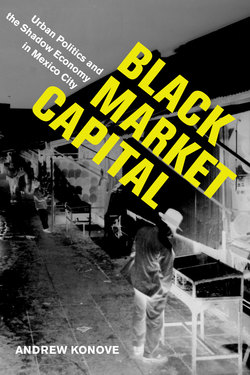Читать книгу Black Market Capital - Andrew Konove - Страница 8
ОглавлениеAcknowledgments
This book began in 2006, when I worked at a small microfinance institution in Oaxaca, Mexico. In my role there, I met women and men who operated businesses at the margins of the law—legitimate, yet not fully legal and therefore without all the protections and remedies the law provides. How, I wondered, did that state of legal ambiguity, in which so many people in Mexico and around the world find themselves today, come into being? What, in other words, is the informal economy’s history? To answer those questions, I sought to understand how a society draws lines, over time, between legal and illegal and tolerable and intolerable exchange. This book on Mexico City’s Baratillo—a marketplace that was illegal but eminently tolerable—is the product of that investigation.
Writing a book requires countless acts of kindness from friends and strangers. A number of people in Mexico City made research on this project possible. The staff of the Archivo Histórico de la Ciudad de México, especially Marlene Pérez, Ricardo Nelson Méndez Cantarell, Alberto Falcón, and Ana Alicia Galindo Méndez, unlocked countless secrets in that archive for me. I am also grateful to the staff at the Archivo General de la Nación, the Archivo General de Notarías, and the Hemeroteca Nacional for their assistance. The Colegio de México offered me an academic home while I was researching the dissertation that became this book. I had the privilege of learning from Marcello Carmagnani, Carlos Marichal, and Sandra Kuntz Ficker while I was there. Guillermina del Valle Pavón, Ernesto Aréchiga Córdoba, and María Eugenia Chaoul became valuable colleagues and friends over the course of this project. Sonia Pérez Toledo was particularly generous, offering thoughtful feedback and access to data that enriched this study. Alfonso Hernández of the Centro de Estudios Tepiteños introduced me to Tepito’s rich street cultures and was a vital resource for the neighborhood’s history. Linda Arnold’s unparalleled knowledge of Mexican archives led me to important finds. Natalia Begún, Cyntia and Sandra González, Armando Martínez, and Sergio Sánchez opened their homes to me on countless occasions while I researched this book. In Oaxaca, I learned from Aurora Vignau, Pablo Albrecht, Caroline Boyd Kronley, and Maureen Keffer, my colleagues and friends at SEFIA.
This project received financial support from the Fox International Fellowship and the MacMillan Center for International and Area Studies at Yale University and the Tinker and Mellon Foundations. The University of Texas at San Antonio’s Internal Research Award and travel grants from the College of Liberal and Fine Arts facilitated the project’s completion. Parts of chapters 2 and 3 first appeared in the article “On the Cheap: The Baratillo Marketplace and the Shadow Economy of Eighteenth-Century Mexico City,” The Americas 72:2 (April 2015): 249–78. They are reproduced here with permission from the publisher. I am grateful to Abraham Parrish, Nazgol Bagheri, Patrick Keller, and Bill Nelson for their work on the maps in this book, and to Jose Garcia for his research assistance.
As a student, I had the privilege of learning from gifted teachers and scholars. Lisa Jane Graham and Jim Krippner first encouraged me to go down this path and they continue to challenge and inspire me to this day. In graduate school, Jean-Christophe Agnew, Seth Fein, and Steve Pincus pushed me to think more broadly and deeply about my work. Stuart Schwartz has provided sage advice and a model for historical research and writing since my first day of graduate school. Pablo Piccato has been a sharp critic and a generous colleague throughout the life of this project. Finally, Gil Joseph is an unparalleled mentor, advocate, and friend.
Over the years, friends and colleagues provided feedback that made this book immeasurably better. Doug Cope kindly pointed me toward the guild records that helped me reconstruct the Baratillo’s history in the eighteenth century. The participants of the Instituto Mora’s La Ciudad de México: Pasado y Presente Seminar; the University of Chicago’s Latin American History Workshop, particularly Brodwyn Fischer and Mauricio Tenorio; and the UTSA–Trinity University History Workshop helped me think about this project in new ways. Sophie Beal, Julie Kleinman, Eric Frith, Gisela Moncada, and Ingrid Bleynat read and commented on the manuscript, in whole or in part, at key moments in its development. I owe a special debt to Tatiana Seijas and Ted Beatty for their feedback and long-term engagement with this project. This book would not have been possible without Kate Marshall and Bradley Depew, my editors at UC Press.
At UT San Antonio, I have benefited from extraordinarily supportive colleagues, particularly Kirsten Gardner, Jerry González, Pat Kelly, Cathy Komisaruk, Gregg Michel, Catherine Nolan-Ferrell, and Jack Reynolds. Catherine Clinton has been a friend and a mentor since the first day of faculty orientation.
My friends encouraged and inspired me throughout the life of this project. Lisa Ubelaker Andrade, Ana Minian, Leslie Theibert, Luke Bassett, Scott Grinsell, and Caleb Linville made graduate school anything but solitary. Jason Johnson’s loyal friendship and spirit of adventure has enlivened my time in Texas. My extended family—Ben Alschuler, Sophie Beal, Anna Bulbrook, Shannon Caspersen, Will Connors, Matt Heck, Prue Hyman, Andy Lapham, and Josh Pressman—has stood behind me for two decades.
Lastly, I thank my family for their unflinching support. My sister, Elissa, has looked after me from day one and provided reasoned advice at every turn. My nieces, Johanna and Miriam, never fail to bring a smile to my face. My mother, Kay, has offered love that knows no bounds. My late father, Ron, was my sounding board and my fiercest advocate. I owe so much to him. No person was a greater source of inspiration than my late brother, Jon. Although he did not get to see me complete this book, I could never have started it without him.
Austin, TX
August 2017
